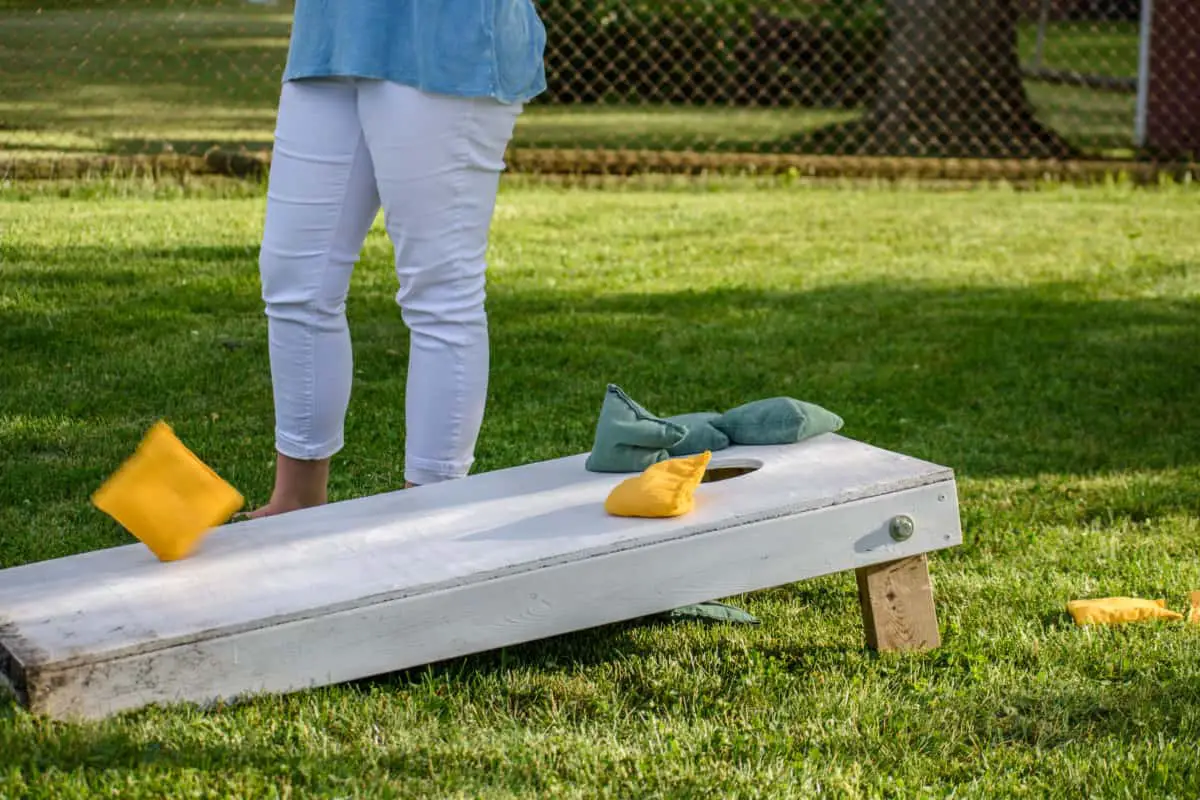Home>Gardening & Outdoor>Outdoor Recreation & Activities>What Happens When You Go Over 21 In Cornhole?


Outdoor Recreation & Activities
What Happens When You Go Over 21 In Cornhole?
Modified: August 20, 2024
Find out the consequences of going over 21 in cornhole and how it affects your outdoor recreation and activities. Learn the rules and strategies to avoid this common mistake.
(Many of the links in this article redirect to a specific reviewed product. Your purchase of these products through affiliate links helps to generate commission for Storables.com, at no extra cost. Learn more)
Introduction
Cornhole, a beloved outdoor game that has gained widespread popularity, is a staple at backyard gatherings, tailgate parties, and recreational events. The game's simplicity, combined with the thrill of competition, makes it a favorite pastime for people of all ages. As players take turns tossing bean bags towards the wooden platform with a hole, the atmosphere is filled with anticipation and camaraderie.
The allure of cornhole lies in its accessibility and the minimal equipment required, making it an ideal choice for casual social gatherings or competitive tournaments. Whether played on a grassy lawn, sandy beach, or paved parking lot, the game's adaptability adds to its universal appeal. The sound of bean bags landing on the platform and the cheers or groans that follow create an atmosphere of lighthearted fun and friendly competition.
As with any game, cornhole has its own set of rules and strategies that contribute to the excitement and challenge. Understanding the rules and nuances of the game is essential for players to fully enjoy the experience and compete effectively. One particular rule that adds an intriguing element to the game is the concept of going over 21 points.
In this article, we will delve into the rules of cornhole, explore the implications of going over 21 points, and discuss the strategies to avoid this predicament. By gaining a comprehensive understanding of these aspects, players can elevate their cornhole skills and enhance their overall enjoyment of the game. So, let's embark on this journey to unravel the intricacies of cornhole and discover the significance of staying under 21 points in this beloved outdoor pastime.
Key Takeaways:
- Going over 21 points in cornhole resets the score to 15, testing players’ resilience and strategic thinking. It adds suspense and highlights the importance of precision and composure in the game.
- To avoid going over 21, teams can use strategic point management, defensive play, and mindful adaptation. These tactics enhance their chances of victory and elevate the excitement of the game.
The Rules of Cornhole
Cornhole, a game that has captured the hearts of many, is governed by a set of straightforward yet essential rules. Understanding these rules is crucial for both casual players and seasoned competitors to ensure fair play and an enjoyable experience for all participants.
Game Setup
The game of cornhole is typically played with two opposing teams, each consisting of two players. The playing area is set up with two elevated wooden platforms, known as cornhole boards, placed a specific distance apart. Traditionally, the distance between the front edges of the boards is 27 feet for casual play and 30 feet for competitive play. Each board features a circular hole, positioned at the center, which serves as the target for the bean bags.
Scoring System
Scoring in cornhole is based on the landing position of the bean bags. A bag that lands on the board and remains on the surface at the end of the frame earns one point. If a bag successfully goes through the hole, it scores three points. The points are tallied at the end of each frame, with the team scoring the most points in a frame being awarded the difference in points as their score for that frame.
Winning the Game
The primary objective of the game is to reach a predetermined score, typically 21 points, before the opposing team. However, a team must win by a margin of two or more points. This means that if both teams reach 21 points simultaneously, the game continues until one team achieves a two-point lead.
Read more: What Happens To Grass When You Cut It
Foul Shots and Distractions
Players are expected to adhere to certain etiquette during gameplay. This includes refraining from distracting or obstructing the opposing team and maintaining a respectful distance from the boards during their opponents' turns. Additionally, any bags that come into contact with the ground before landing on the board are considered foul shots and are promptly removed from play.
Going Over 21
One of the most intriguing aspects of cornhole is the rule related to going over 21 points. This rule adds an element of strategy and suspense to the game, as surpassing 21 points can lead to significant consequences for the scoring team.
Understanding and adhering to these fundamental rules is essential for players to fully engage in the game and compete effectively. By familiarizing themselves with the rules of cornhole, players can ensure a fair and enjoyable experience, whether they are playing for leisure or participating in competitive tournaments.
Going Over 21: What It Means
In the realm of cornhole, reaching the score of 21 points is the ultimate goal, signifying a team's triumph in the game. However, the concept of going over 21 introduces a captivating twist to the gameplay. When a team's total score surpasses 21 points, it triggers a series of repercussions that can dramatically alter the course of the game.
Going over 21 in cornhole is not merely a numerical inconvenience; it carries substantial implications for the scoring team. In essence, the team's score is reset to 15 points, undoing the progress they have made in the game. This setback can be disheartening for the team, especially if they were on the brink of victory. The reset serves as a humbling reminder of the importance of strategic gameplay and the need for precision in scoring.
The rule of reverting to 15 points upon exceeding 21 adds an element of suspense and strategic calculation to the game. Teams must carefully strategize their throws to avoid overshooting the 21-point threshold, as doing so can potentially jeopardize their lead and reset the game in favor of the opposing team. This rule underscores the significance of not only scoring points but also managing the pace of the game to prevent an inadvertent reset.
Furthermore, going over 21 in cornhole highlights the psychological aspect of the game. It tests the resilience and composure of the scoring team, as they must regroup and strive to regain their momentum after the setback. This aspect adds depth to the game, requiring players to exhibit mental fortitude and adaptability in the face of unforeseen challenges.
The implications of going over 21 in cornhole extend beyond the numerical aspect, permeating the strategic, psychological, and competitive dimensions of the game. It serves as a reminder that in cornhole, precision, foresight, and composure are paramount in achieving victory. By understanding the significance of staying under 21 points, players can refine their approach to the game, heighten their strategic acumen, and savor the exhilarating journey of cornhole with a newfound appreciation for its intricacies.
Consequences of Going Over 21
When a team's cumulative score exceeds 21 points in a game of cornhole, the consequences are not merely numerical; they have a profound impact on the dynamics and outcome of the game. The rule stipulating a reset to 15 points upon surpassing 21 introduces a series of compelling consequences that can shift the momentum and test the resilience of the scoring team.
First and foremost, going over 21 in cornhole entails a significant setback for the scoring team. The reset to 15 points nullifies the progress they have made, effectively erasing their hard-earned lead and compelling them to recalibrate their strategy. This setback can be demoralizing, especially if the team was on the cusp of victory. It underscores the unforgiving nature of the game and the need for unwavering focus and precision in scoring.
Moreover, the consequences of going over 21 extend beyond the numerical aspect, permeating the psychological and strategic dimensions of the game. The scoring team is confronted with the challenge of regaining their momentum and composure after the setback. This demands mental fortitude, adaptability, and strategic acumen, as they must navigate the psychological impact of the reset and realign their approach to regain control of the game.
Additionally, going over 21 serves as a pivotal turning point in the game, injecting a surge of adrenaline and suspense into the proceedings. The opposing team seizes the opportunity to capitalize on the reset, aiming to exploit the scoring team's vulnerability and gain a decisive advantage. This creates a dramatic shift in the game's dynamics, intensifying the competitive fervor and underscoring the strategic significance of staying below the 21-point threshold.
Furthermore, the consequences of going over 21 underscore the paramount importance of precision and foresight in cornhole. It serves as a poignant reminder that in this seemingly simple yet captivating game, every throw carries weight, and every decision shapes the course of the game. This realization compels players to approach each toss with meticulous calculation and unwavering focus, heightening the strategic depth and intensity of the gameplay.
In essence, the consequences of going over 21 in cornhole transcend mere numerical implications, permeating the psychological, strategic, and competitive facets of the game. It serves as a compelling testament to the unforgiving yet exhilarating nature of cornhole, challenging players to exhibit resilience, adaptability, and unwavering precision in their pursuit of victory.
Read more: What Happens When You Breathe In Insulation
Strategies to Avoid Going Over 21
Mastering the art of cornhole involves not only honing throwing techniques but also devising strategic approaches to prevent the perilous scenario of going over 21 points. Implementing astute strategies can significantly enhance a team's chances of maintaining control and securing victory in this exhilarating outdoor game.
-
Strategic Point Management: A fundamental strategy to avoid going over 21 revolves around astute point management. Teams must meticulously calculate their throws to inch closer to the coveted 21-point threshold without overshooting it. This entails gauging the current score, assessing the opposing team's position, and strategically distributing point-scoring throws to maintain a competitive edge while mitigating the risk of a reset.
-
Defensive Play: Employing a defensive approach can be instrumental in preventing an inadvertent reset. By strategically placing bean bags to obstruct the path to the hole or create challenging positions for the opposing team, players can exert subtle pressure and impede the opponent's scoring opportunities. This defensive stance not only safeguards the team's lead but also introduces an element of strategic disruption, compelling the opposing team to recalibrate their throws.
-
Strategic Sacrifice: In certain scenarios, strategically sacrificing a throw to prevent going over 21 can be a prudent maneuver. By deliberately aiming for a lower-scoring position on the board or strategically directing throws to secure one-point scores, teams can tactically regulate their progress, ensuring that they remain below the critical 21-point threshold. This calculated sacrifice underscores the team's strategic foresight and their commitment to maintaining a favorable position in the game.
-
Mindful Adaptation: Flexibility and adaptability are pivotal in navigating the intricacies of cornhole. Teams must remain mindful of the evolving dynamics of the game, adjusting their strategy in response to the opposing team's maneuvers and the shifting score differential. This mindful adaptation enables teams to recalibrate their approach, capitalize on scoring opportunities, and tactically navigate the delicate balance between accumulating points and evading the peril of going over 21.
-
Strategic Communication: Effective communication between team members is indispensable in orchestrating cohesive and strategic gameplay. By exchanging insights, discussing tactical approaches, and collectively assessing the scoring landscape, teams can synergize their efforts and execute calculated throws that align with their overarching strategy. This collaborative approach fosters a unified front, enabling teams to navigate the game's complexities with precision and cohesion.
By integrating these strategic approaches into their gameplay, teams can adeptly navigate the nuances of cornhole, mitigate the risk of going over 21, and elevate their competitive prowess. Embracing strategic acumen and precision, players can savor the exhilarating journey of cornhole while strategically maneuvering to secure victory and revel in the camaraderie of this beloved outdoor pastime.
Conclusion
In the realm of outdoor recreation and social camaraderie, cornhole stands as a timeless emblem of lighthearted competition and convivial gatherings. As bean bags soar through the air and land with precision on wooden platforms, the game weaves a tapestry of excitement, strategy, and shared moments of triumph and setback. The journey through the rules, implications, and strategies of cornhole unveils a captivating narrative that transcends mere gameplay, offering profound insights into the essence of sportsmanship, strategic acumen, and the resilience of the human spirit.
The rules of cornhole, with their simplicity and precision, lay the foundation for an engaging and equitable gameplay experience. From the meticulous setup of the boards to the scoring system that rewards precision and skill, the rules foster an environment where players of all levels can partake in the thrill of competition and revel in the joy of shared recreation. However, it is the rule of going over 21 points that introduces a compelling twist, infusing the game with suspense, strategic calculation, and the test of mental fortitude.
The consequences of going over 21 in cornhole extend far beyond the numerical reset; they encapsulate the psychological and strategic dimensions of the game. The setback serves as a crucible, testing the resilience and adaptability of the scoring team while injecting a surge of adrenaline and suspense into the proceedings. It underscores the unforgiving yet exhilarating nature of the game, compelling players to exhibit unwavering precision and composure in the face of unforeseen challenges.
The strategies to avoid going over 21 in cornhole serve as a testament to the artistry and strategic depth inherent in the game. From astute point management to mindful adaptation and strategic sacrifice, these approaches underscore the significance of foresight, collaboration, and calculated gameplay. By integrating these strategies into their approach, players can navigate the delicate balance between accumulating points and evading the peril of going over 21, elevating their competitive prowess and reveling in the camaraderie of this beloved outdoor pastime.
In essence, the journey through the intricacies of cornhole unveils a narrative that transcends the boundaries of a mere game. It embodies the spirit of resilience, strategic acumen, and the joy of shared recreation, weaving a tapestry of moments that resonate with players and enthusiasts alike. As bean bags continue to sail through the air, landing with precision and eliciting cheers and groans, the allure of cornhole endures, inviting players to embark on an exhilarating journey that transcends the boundaries of a mere game, embracing the essence of camaraderie, strategic finesse, and the unwavering pursuit of victory.
Frequently Asked Questions about What Happens When You Go Over 21 In Cornhole?
Was this page helpful?
At Storables.com, we guarantee accurate and reliable information. Our content, validated by Expert Board Contributors, is crafted following stringent Editorial Policies. We're committed to providing you with well-researched, expert-backed insights for all your informational needs.














0 thoughts on “What Happens When You Go Over 21 In Cornhole?”